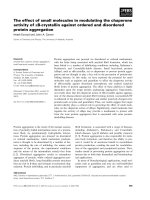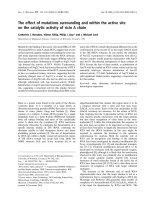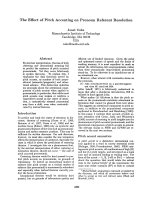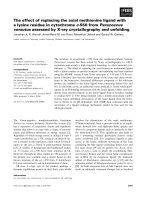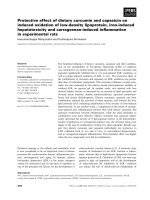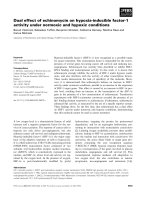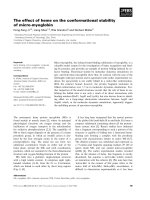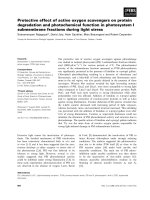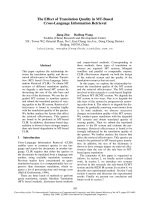Báo cáo khoa học: " Carry-over effect of gibberellins (GA and ringing ) 4/7 on female flowering in Norway spruce (Picea abies (L) Karst) seedlings" pdf
Bạn đang xem bản rút gọn của tài liệu. Xem và tải ngay bản đầy đủ của tài liệu tại đây (264.22 KB, 5 trang )
Original
article
Carry-over
effect
of
gibberellins
(GA4/7
)
and
ringing
on
female
flowering
in
Norway
spruce
(Picea
abies
(L)
Karst)
seedlings
W
Chalupka
Polish
Academy
of Sciences,
Institute
of Dendrology,
62-035
Kórnik,
Poland
(Received
11
December
1995;
accepted
7
May
1996)
Summary -
The
second
year
after
treatment
effect
of
gibberellins
(GA4/7
)
and
ringing
on
increased
female
flowering
was
observed
in
13-year-old
full-sibs
of
Norway
spruce.
This
carry-over
effect
was
exhibited
independently
by
GA
4/7
and
ringing.
GA
4/7
significantly
increased
and
ringing
sig-
nificantly
decreased
height
growth
increment
of
trees
in
a
year
of
flower
bud
initiation.
The
influence
of
GA
4/7
and
ringing
on
flower
initiation
and
height
increment
is
discussed.
Picea
abies
/
first
flowering
/
carry-over
effect
/
GA
4/7
/
ringing
Résumé -
Effets
différés
des
gibbérellines
4/7
et
de
l’annélation
sur
la
floraison
femelle
de
semis
d’épicéa
commun
(Picea
abies
(L) Karst).
Deux
années
après
traitement
l’effet
de
gibbérellines
4/7
(GA4/7
)
et
de
l’annélation
d’écorce
sur
la
floraison
femelle
a
été
observé
sur
des
descendants
plein-frères
de
familles
d’épicéa
commun.
Cet
effet
différé
se
manifeste
indépendamment
en
réponse
à
GA
4/7
et
à
l’annélation.
L’année
d’initiation
florale,
GA
4/7
augmente
significativement
l’accrois-
sement
en
hauteur
des
arbres,
tandis
que
l’annélation
le
diminue
significativement.
Les
influences
res-
pectives
de
GA
4/7
et
de
l’annélation
sur
l’initiation
florale
et
sur
l’accroissement
en
hauteur
sont
discutées.
Picea
abies
/
première
floraison
/
effet
différé
/
GA
4/7
/
annélation
Tel :
(48)
61
170 033;
fax:
(48)
61
170 166
INTRODUCTION
Cone
induction
in
Norway
spruce
is
not
easy
to
attain
and
most
of
the
positive
results
in
the
stimulation
of
flowering
in
that
species
have
been
obtained
using
grafted
material
both
in
the
field
and
in
greenhouses
(Luukkanen,
1980;
Chalupka,
1985).
Bonnet-Masimbert
(1987, 1989)
was
the
first
to
succeed
in
the
stimulation
of
flow-
ering
in
Norway
spruce
seedlings
and
cut-
tings
in
greenhouse
and
field
conditions.
Using
gibberellins
(GA4/7
)
and
girdling
he
noticed
a
carry-over
effect,
observing
flow-
ering
2
years
after
the
treatment
(Bonnet-
Masimbert,
1987).
Similar
results
concern-
ing
a
carry-over
effect
were
obtained
for
Japanese
and
European
larch
grafts
(Heit-
müller
and
Melchior,
1960;
Melchior,
1960;
Bonnet-Masimbert,
1982),
Douglas-fir
seedlings
(Pharis
et
al,
1980),
Sitka
spruce
grafts
(Philipson,
1985)
and
Engelmann-
white
spruce
grafts
(Ross,
1992).
The
aim
of
the
current
experiment
was
to
investigate
the
flowering
response
of
Nor-
way
spruce
seedlings
to
GA
4/7
and
ringing
applied
alone
and
in
combination.
MATERIALS
AND
METHODS
In
the
spring
of 1991
four
full-sib
families
of
Norway
spruce
(nos.
1958,
1982,
1990,
1991)
were
selected,
each
represented
by
12
seedlings.
The
full-sibs
resulted
from
1980
control
crossings
done
on
a
first
generation
seed orchard of
Nor-
way
spruce
in
Kórnik,
Poland.
Seeds
were
sown
in
the
nursery
in
spring
of
1981,
and
seedlings
were
outplanted
in
spring
1984
with
random
dis-
tribution
(single
tree
plots)
within
the
experi-
mental
area.
Their
average
height
in
1991
was
282
cm
(range
206-400
cm).
Seedlings
within
a
family
were
treated
with
i)
GA
4/7
,
ii)
ringing,
iii)
GA
4/7
+
ringing
and
iv)
no
treatment
(con-
trol).
There
were
three
seedlings
(replicates)
per
treatment
per
family.
GA
4/7
was
dissolved
in
ethanol
at
a
333
mg
x
mL-1
concentration
and
injected
into
the
trees
once
on
20
June.
The
injec-
tion
was
done
into
a
bored
hole
at
the
base
of
the
1989
internode
on
the
stem
using
a
micropipette.
The
amount
of
GA
4/7
solution
injected
into
each
seedling
was
300
μl,
ie,
100
mg
of
GA
4/7
.
Ringing
was
done
on
19
June
as
semi-
circular
knife
cuts
without
removing
bark,
and
the
distance
between
the
two
semi-girdles
was
about
2
cm.
An
analysis
of
variance
(JMP
version
3.0.2.,
SAS
Institute,
Inc)
was
used
for
statistical
eval-
uation
of
the
number
of
female
cones
produced
in
1993
and
annual
tree
height
increment
data
for
1991
and
1992.
RESULTS
1992
observations
There
were
no
cones
in
the
year
1992
on
trees
under
experiment.
This
was
a
year
without
flowering
on
any
Norway
spruce
experimental
plot
located
in
Kórnik.
1993
flowering
response
No
flowering
was
observed
on
control
trees
and
numerous
cones
were
noted
on
the
treated
individuals,
where
the
number
of
cones
per
seedling
varied
from
one
to
40
(table
I).
Both
GA
4/7
and
ringing
signifi-
cantly
enhanced
the
number
of
female
cones
per
treated
seedling
(table
IIa
and
b).
Neither
differences
between
families
nor
any
of
the
interactions
between
factors
were
statisti-
cally
significant.
There
were
no
male
strobili
on
the
treated
seedlings.
Height
increment
response
A
significant
GA
4/7
x
ringing
interaction
was
observed
on
the
1991
height
increment
of
trees
(tables
III
and
IV),
and
1
year
later
(in
1992)
GA
4/7
as
well
as
ringing
influ-
enced
significantly
the
height
increment
of
treated
trees
(table
III):
the
GA
4/7
treatment
increased
stem
height
increment
from
39.7
to
49.7
cm,
while
ringing
reduced
it
from
50.8
to
38.2
cm.
Significant
differences
were
also
observed
between
families
(tables
III
and
V).
DISCUSSION
The
year
1993
was
characterized
by
very
abundant
female
flowering
of
Norway
spruce
not
only
in
our
experimental
plots
but
also
throughout
Poland.
This
flowering
probably
resulted
from
the
very
sunny
June
of
1992
when
average
daily
sunshine
was
10.5
h.
According
to
Chalupka
(1975)
a
minimum
9
h
daily
sunshine
in
June
is
needed
for
a
good
Norway
spruce
cone
crop
the
next
year.
The
1993
flowering
was
the
first
observed
on
the
experimental
seedlings
and
all
flowers
were
initiated
above
the
place
of
the
GA
4/7
injection
and/or
ringing.
Results
obtained
clearly
revealed
a
carry-
over
effect
of both
GA
4/7
and
ringing
in
the
stimulation
of female
flowering
in
Norway
spruce
seedlings
in
the
second
year
after
treatment,
even
though
the
ringing
alone
effect
was
rather
small
(table
I).
This
could
be
explained
by
the
method
of
ringing
trees
with
very
slight
knife
cuts
without
bark
removing.
These
results
confirmed
those
obtained
by
Bonnet-Masimbert
(1987).
The
effect
in
the
second
year
after
treat-
ment
has
usually
been
attributed
to
girdling
and/or
strangulation
alone
(Heitmüller
and
Melchior,
1960;
Melchior,
1960;
Ross,
1992),
or
to
the
interaction
of
GA
4/7
and
girdling
(Pharis
et
al,
1980;
Bonnet-Masim-
bert,
1982,
1987;
Philipson,
1985).
This
is
the
first
time
when
the
carry-over
effect
appeared
also
as
a
result
of
GA
4/7
alone.
Bonnet-Masimbert
(1987)
explained
the
carry-over
effect
as
an
indirect
effect
of
treatment
on
shoot
vigor
or
bud
size
that
could
affect
cone
initiation
in
the
following
year.
In
his
experiment
girdling
alone
or
with
GA
4/7
increased
the
terminal
shoot
elongation
the
next
year,
which
was
the
cone
initiation
year.
In
my
experiment
only
the
GA
4/7
increased
tree
height
increment,
while
ring-
ing
reduced
it
in
the
year
of
cone
initiation.
Such
contrasting
results
indicate
that
the
mode
of
action
of
gibberellins
or
ringing
is
not
explainable
by
growth
per
se.
It
might
involve
other
aspects
of
growth
processes
during
the
year
preceding
the
year
of
flower
initiation,
eg,
mitotic
activity
and
subse-
quent
changes
in
the
shoot
apex
structure.
This
suggestion
is
supported
by
the
results
of
Hejnowicz
and
Obarska
(unpublished),
who
showed
an
increase
of
mitotic
activity
in
the
apical
meristems
and
cataphyll
primordia
in
Norway
spruce
after
GA
4/7
spraying;
this
resulted
1 year
later
in
an
increase
of
bud
length
on
sprayed
shoots.
Similar
results
were
obtained
for
Scots
pine
(Hejnowicz,
1987).
It
was
revealed
earlier
that
an
abundant
cone
crop
in
Norway
spruce
was
signifi-
cantly
correlated
with
specific
weather
pat-
terns
for
2
years
before
flowering
(eg,
June
temperature
and
July
sunshine
1 year
before
flower
initiation,
and
June
sunshine
and
tem-
perature
1
year
before
flowering)
(Chalupka,
1975).
This
could
support
a
carry-over
effect
in
flower
stimulation
in
Norway
spruce.
Recently,
Hejnowicz
and
Obarska
(1995)
described
in
Norway
spruce
an
autumn
ini-
tiation
of
first
bud
scale
primordia
for
the
bud
formed
the
next
growing
season.
Thus
it
is
possible
that
in
a
year
preceding
flower
induction
GA
4/7
and/or
other
treatments
(also
climatic
factors)
function
as
trigger-
ing
agents
inducing
initial
changes
in
the
apical
meristems
which
lead
to
reproduc-
tive
as
opposed
to
vegetative
development
(Cha&jadnr;upka,
1980).
Different
factors
or
treatments
applied
1
year
before
flower
induction
could
make
the
tree
apical
meristems
more
susceptible
to
the
influence
of
some
direct
floral
induc-
tion
stimulus.
In
the
1991
experiment
a
proper
amount
of
solar
energy
expressed
by
very
high
daily
sunshine
in
June
1992,
ie,
during
the
time
of
generative
structure
dif-
ferentiation,
could
be
such
a
stimulus.
ACKNOWLEDGMENTS
The
basic
work
for
this
experiment
was
done
by
the
late
Dr
G
Kosi&jadnr;ski,
who
did
the
control
cross-
ings,
raised
seedlings
and
established
the
exper-
imental
plot.
REFERENCES
Bonnet-Masimbert
M
(1982)
Effect
of
growth
regula-
tors,
girdling,
and
mulching
on
flowering
of
young
European
and
Japanese
larches
under
field
condi-
tions.
Can
J
For
Res
12, 270-279
Bonnet-Masimbert
M
(1987)
Preliminary
results
on
gibberellin
induction
of
flowering
of
seedlings
and
cuttings
of
Norway
spruce
indicate
some
carry-
over
effects.
For
Ecol Manage
19,
163-171
Bonnet-Masimbert
M
(1989)
Field
experiment
on
the
effect
of
girdling
and
gibberellin
application
on
flowering
induction
of
12-yr-old
seedlings
of
Dou-
glas
fir
and
Norway
spruce.
Ann
Sci
For
46
(suppl),
47s-50s
Chalupka
W
(1975)
Wp&jadnr;yw
czynników
klimatycznych
na
urodzaj
szyszek
u
&jadnr;wierka
pospolitego
(Picea
abies
(L) Karst)
w
Polsce
[Relation
between
cone
crops
of
Picea
abies
((L)
Karst)
in
Poland
and
the
climatic
factors].
Arbor
Kórnickie
XX,
213-225
Chalupka
W
(1980)
Regulation
of flowering
in
Scots
pine
(Pinus
sylvestris
L)
grafts
by
gibberellins.
Sil-
vae Genet 29,
118-121
Chalupka
W
(1985)
Regulacja
kwitnienia
na
plantac-
jach
nasiennych
sosny
zwyczajnej
(Pinus
sylvestris
L)
i
&jadnr;wierka
pospolitego
(Picea
abies
(L)
Karst)
[Regulation
of Flowering
in
Seed
Orchards
of Scots
Pine
(Pinus
sylvestris
L)
and
Norway
Spruce
(Picea
abies
(L)
Karst)].
Instytut
Dendrologii
PAN,
Kórnik,
Poland,
146
p
Heitmüller
HH,
Melchior
GH
(1960)
Über
die
Blüh-
fördernde
Wirkung
des
Wurzelschnitts,
des
Zweigkrümmens
und
der
Strangulation
an japanis-
cher
Lärche
(Larix
leptolepis
(Sieb
&
Zucc)
Gord).
Silvae
Genet
9, 65-72
Hejnowicz
A
(1987)
Changes
in
the
development
of
apical
meristem
of
Pinus
sylvestris
in
response
to
gibberellin
application.
For
Ecol Manage
19, 99-
106
Hejnowicz
A,
Obarska
E
(1995)
Structure
and
devel-
opment
of
vegetative
buds,
from
the
lower
crown
of
Picea
abies.
Ann
Sci
For
52, 433-447
Luukkanen
O
(1980)
Hormonal
treatment
increases
flowering
of
Norway
spruce
grafts
grown
in
a
plas-
tic
greenhouse.
Finn
Found
For
Tree
Breed
Ann
Rep
1979, 21-26
Melchior
GH
(1960)
Ringelungsversuche
zur
Steigerung
der
Blühwilligkeit
anjapanischer
Lärche
(Larix
leptolepis
(Sieb
&
Zucc) Gord)
und
an
europäischer
Lärche
(Larix
decidua
Mill).
Silvae
Genet
9,
105-111
Pharis
RP,
Ross
SD,
McMullan
E
(1980)
Promotion
of
flowering
in
the
Pinaceae
by
gibberellins.
III.
Seedlings
of
Douglas
fir.
Physiol
Plant
50,
119-
126
Philipson
JJ
(1985)
The
promotion
of
flowering
in
large
field-grown
Sitka
spruce
by
girdling
and
stem
injection
of
gibberellin
A
4/7
.
Can
J
For
Res
15,
166-170
Ross
SD
(1992)
Promotion
of
flowering
in
Engelmann-
white
spruce
seed
orchards
by
GA
4/7
stem
injec-
tion:
effects
of
site,
clonal
fecundity,
girdling
and
NAA,
and
treatment
carry-over
effects.
For
Ecol
Manage
50,
43-55
